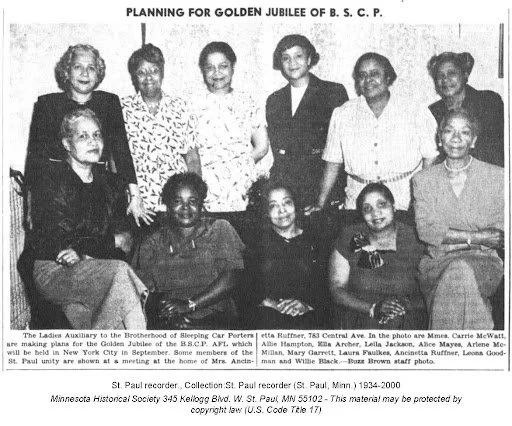Phyllis Wheatley House
Dates of operation: 1924-1962
Dates Listed in Green Book: 1939-1961
In the 1920s, Black travelers could not stay at most hotels in the Twin Cities. Black students could not live on campus at the University of Minnesota. Black people were also excluded from settlement houses, which provided education, short-term housing, and other services in low-income neighborhoods. The Women’s Cooperative Alliance (WCA) and other agencies in Minneapolis collaborated to create a space where Black people could find access to both social services and recreation. The WCA purchased what used to be a Jewish school at 808 Bassett Place, Minneapolis, and began renovations in 1920. In 1924, the Phyllis Wheatley Settlement House opened its doors.
Miss W. Gertrude Brown, Head Resident of Phyllis Wheatley House, photo courtesy of the WPA Collection, Hennepin County Library
The reception desk at Phyllis Wheatley House circa 1948, photo courtesy of Minnesota Historical Society
Listen to Langston Hughes read his poems! Perhaps he did private readings while staying at the Phyllis Wheatley House…
The Wheatley House was much more involved in activism and advocacy than other settlement houses. In collaboration with the Urban League, the Wheatley House founded the Black Worker’s Alliance and the Workers’ Education Program. The City of Minneapolis hired its first Black policewoman thanks to the house’s advocacy. The Wheatley House also campaigned to stop the showing of Birth of a Nation, a violently racist film.
The Wheatley House stopped offering lodging in the 1950s. In 1962, it became the Phyllis Wheatley Community Center. The building at 809 Aldrich Avenue N was demolished in 1970 to make way for Interstate 94. The Community Center moved less than a mile away, and continues to provide social and educational programs today.
Ethel Waters, Paul Robeson, and Marian Anderson were all Wheatley House guests! Listen to this playlist to hear some of their music.
Can you imagine hearing them practice while staying at the Phyllis Wheatley House?
The reception desk at Phyllis Wheatley House circa 1948, photo courtesy of Minnesota Historical Society
timeline
Addresses:
809 Aldrich Avenue North, Minneapolis
1301 10th Avenue North, Minneapolis
W. Gertrude Brown, a Black social worker, served as the first head resident of the Wheatley House. Ethel Ray Nance, a Black activist and writer, was the assistant head resident. The two women worked together to broaden the house’s social programs beyond what settlement houses typically offered. By 1929, the Wheatley House moved to a new location at 809 Aldrich Avenue N. This larger space allowed them to provide healthcare services, a library, a day care, and expanded housing and recreational activities.
The Wheatley House was known for providing lodging to renowned Black authors, artists, and activists. Langston Hughes, W.E.B. DuBois, Marian Anderson, and Paul Robeson were among its many guests. Longer-term residents included Black college students who lived there during the school year. One such student was John Pinkett Jr., who was forced out of an all-white dorm at the University of Minnesota in 1931.







